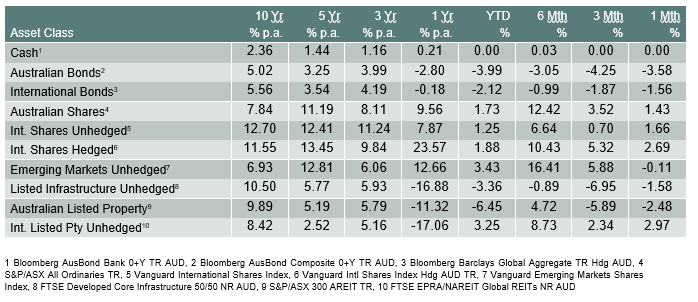Market Review – February 2021
How the different asset classes have fared:
(As at 28 February 2021)

Australia Equities
The S&P/ASX All Ords recorded a gain of 1.43% in February. It was a volatile month for Australian shares due to fears of inflation and a possible lift in interest rates in the near future. The best performing sectors for the month were materials, financials, and energy, which were expected to benefit from an economic recovery as vaccines drive normalisation in the economy and rising bond yields pressure valuations.
Reporting season saw the release of earnings data, with many ASX companies beating expectations. Roughly 86 percent of ASX 200 companies reported a profit. The better-than-expected earnings were partly a function of the disruption in 2020 when many companies ditched forecasts entirely, leaving analysts forecasting earnings in the dark, because of the uncertainty stemming from the pandemic.
Australian Property
The Australian property market performed well in February, having risen at its fastest rate in 17 years. The property market has been more resilient than expected, helping the economic recovery and the performance of banks and developers. Much of this growth has been attributed to record low interest rates, multiple government home buyer and income support measures, pent up demand from lockdowns and a fear of buyers’ missing out.
Australian dollar
Higher than anticipated iron ore prices kept the Australian dollar high, despite the RBA extending its bond-buying program to place downward pressure on the local currency.
International Equities
US Stocks performed well in February with the S&P 500 up 2.61%. This can be attributed to growing optimism surrounding the economic recovery and decreasing number of COVID-19 infections. Nevertheless, attention turned to rising yields on the U.S. 10-year treasury notes. There is growing fear that increasing yields, which are a consequence of an improving economy and greater pricing pressures, will prove competition for stocks. The casualties have been overbought high multiple growth stocks, many of which are traded on the NASDAQ and are tech related. The inevitable stylistic shift back in markets to value-oriented stocks and stocks which are more favourably exposed to rising bond yields appears to be occurring.
Asian and European markets did reasonably well, however they experienced a strong sell off in the last trading day of the month as investors bet an economic rebound could lead to tighter monetary policy. Technology stocks were hardest hit during the sell off.
Domestic and International Fixed Income
The RBA has an official policy to keep 3-year government bond yields at around 0.1%. To do this, it buys bonds when the yield gets too high. Earlier in the month, the RBA announced another $100 billion in bond purchases, which means the RBA will be buying about $5 billion worth of government bonds every week until at least April. This is intended to help the economy by keeping other interest rates very low. Nevertheless, despite the RBA efforts, long-term 10-year interest rates have doubled since November. And that’s because investors are starting to look ahead of the pandemic to possible inflation.
Internationally, central banks from Asia to Europe escalated efforts to calm panicking markets, by pledging to buy more bonds and signaling more policy accommodation, after U.S Treasury yields surged to their highest level in a year.
Disclaimer
The information provided in this communication has been issued by Centrepoint Alliance Ltd and Ventura Investment Management Limited (AFSL 253045).
The information provided is general advice only has not taken into account your financial circumstances, needs or objectives. This publication should be viewed as an additional resource, not as your sole source of information. Where you are considering the acquisition, or possible acquisition, of a particular financial product, you should obtain a Product Disclosure for the relevant product before you make any decision to invest. Past performance does not necessarily indicate a financial product’s future performance. It is imperative that you seek advice from a registered professional financial adviser before making any investment decisions.
Whilst all care has been taken in the preparation of this material, no warranty is given in respect of the information provided and accordingly neither Centrepoint Alliance Ltd nor its related entities, guarantee the data or content contained herein to be accurate, complete or timely nor will they have any liability for its use or distribution.
